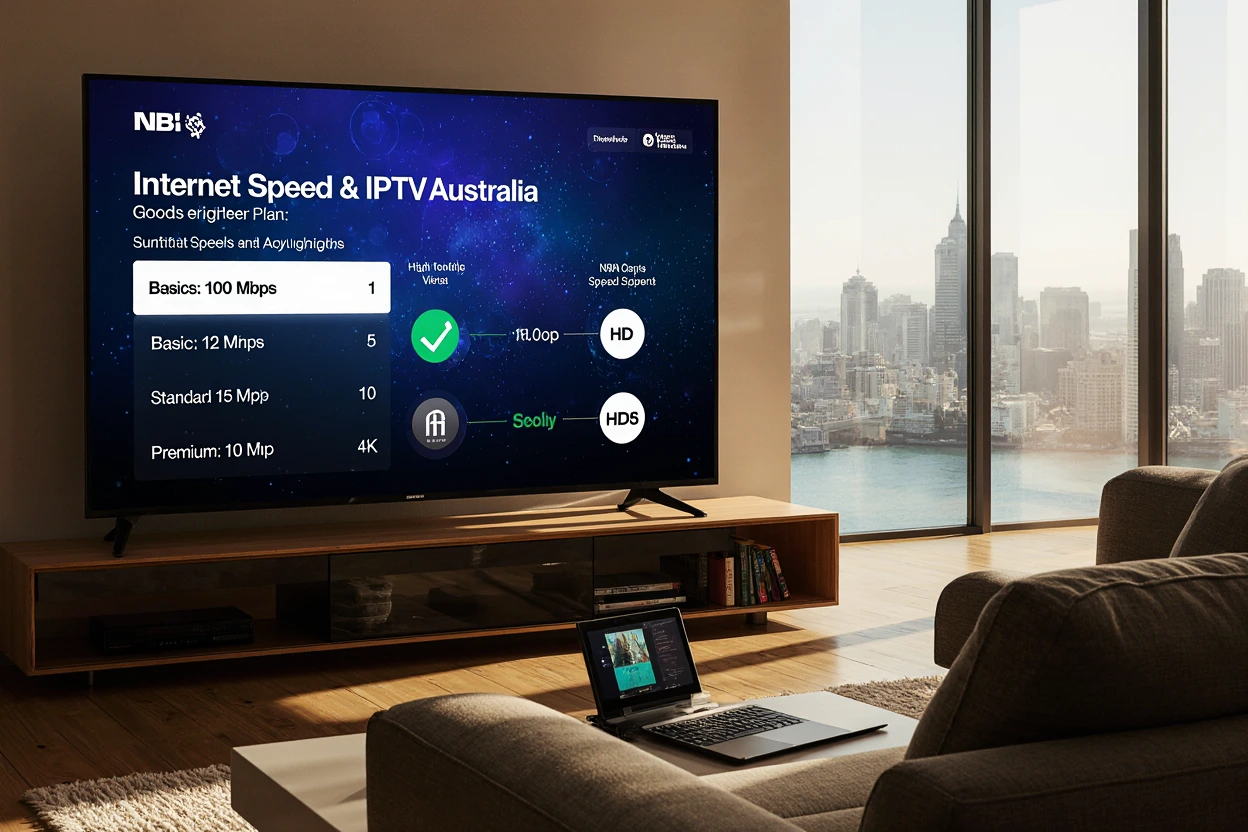
Internet Speed and IPTV in Australia is a topic I’ve wrestled with firsthand, spending countless evenings in my Sydney apartment troubleshooting buffering streams and sluggish connections.
As a remote worker and avid IPTV user, I’ve learned through trial and error how to achieve a seamless streaming experience.
In this guide, I’ll share my personal journey of optimizing Internet Speed and IPTV in Australia, offering practical, tested tips to help you enjoy lag-free streaming. From selecting the right NBN plan to fine-tuning your home network, this article covers everything you need to know for a smooth IPTV experience in 2025.
Why Internet Speed is Critical for IPTV in Australia
In Australia, where internet quality varies from bustling cities like Melbourne to remote Outback regions, Internet Speed and IPTV in Australia are deeply intertwined. IPTV delivers TV content over the internet, making your connection’s speed, latency, and bandwidth crucial for a buffer-free experience. When I first subscribed to an IPTV service, I was excited to access global channels, but my 25 Mbps plan led to constant buffering. A speed test revealed I was barely hitting 15 Mbps during peak hours, teaching me that advertised speeds aren’t always what you get.
For IPTV to shine, you need consistent download speeds: at least 10 Mbps for standard definition (SD), 25 Mbps for high definition (HD), and 50 Mbps or more for 4K. If your household juggles multiple devices—like my smart TV, laptop, and phone—bandwidth demands grow. My first step? Regularly testing my Internet Speed and IPTV in Australia compatibility to pinpoint issues.
How to Test Your Internet Speed for IPTV in Australia
Early on, I mistakenly trusted my plan’s advertised speed. A free speed test using Ookla’s Speedtest showed my actual download speed was far lower, especially in the evenings. To optimize Internet Speed and IPTV in Australia, I now run speed tests at different times using tools like Fast.com or Speedtest.net. If your results fall short of your plan’s promise, contact your ISP. Upgrading to a 100 Mbps NBN plan transformed my IPTV streams, eliminating buffering even during peak hours.
Best NBN Plans for IPTV Streaming in Australia
When I moved to Sydney’s Inner West, my 50 Mbps NBN plan struggled with Internet Speed and IPTV in Australia, especially when my partner streamed Netflix simultaneously. Researching NBN tiers helped me choose a plan that matched my streaming needs.
Comparing NBN Plans for IPTV
Australia’s NBN offers speed tiers from Basic (12 Mbps) to Ultrafast (1000 Mbps). Below is a comparison of NBN plans and their IPTV performance, based on my experience:
| NBN Plan | Download Speed | IPTV Quality | Best For |
|---|---|---|---|
| Basic | 12 Mbps | SD (some buffering) | Light users |
| Standard | 25 Mbps | HD (occasional lag) | Small families |
| Standard Plus | 50 Mbps | HD, minimal lag | Average households |
| Premium | 100 Mbps | 4K, no lag | IPTV enthusiasts |
| Ultrafast | 250–1000 Mbps | 4K, multi-device | Heavy streamers |
Upgrading to a 100 Mbps Premium plan was a game-changer for Internet Speed and IPTV in Australia, delivering crystal-clear 4K streams. If you’re in a regional area, check if fixed wireless or satellite NBN can provide stable speeds, as these can be less consistent than fibre.
Avoiding Peak-Hour Slowdowns
Peak hours (7–10 PM) can tank Internet Speed and IPTV in Australia due to neighborhood congestion. My ISP offered a priority option for a small fee, which stabilized my streams. Alternatively, scheduling IPTV viewing for off-peak times can save money while maintaining quality.
Optimizing Your Home Network for IPTV in Australia
Even with a fast NBN plan, your home setup can bottleneck Internet Speed and IPTV in Australia. I learned this when my streams froze despite my 100 Mbps plan, pointing to Wi-Fi issues.
Wired vs. Wireless for IPTV Streaming
Switching to a wired Ethernet connection was a revelation. Wi-Fi signals in my multi-story apartment were weakened by walls and interference. A 10-meter Ethernet cable from my router to my smart TV slashed latency and boosted Internet Speed and IPTV in Australia. If cables aren’t feasible, powerline adapters can extend your network using electrical wiring.
Upgrading Your Router for IPTV
My ISP’s basic router couldn’t handle multiple devices. Investing in a dual-band router with Quality of Service (QoS) settings revolutionized my setup. QoS lets you prioritize IPTV traffic, ensuring Internet Speed and IPTV in Australia stays smooth even when others are online. I set my smart TV as the priority device, and buffering vanished. Opt for a Wi-Fi 5 (802.11ac) or Wi-Fi 6 (802.11ax) router for larger households.
Managing Bandwidth-Hogging Devices
With roommates, I noticed Internet Speed and IPTV in Australia suffered when someone downloaded large files. Using my router’s app, I now limit bandwidth for non-essential devices during IPTV sessions. If your router lacks this feature, coordinate with household members to avoid heavy downloads during peak streaming times.
Troubleshooting IPTV Issues in Australia
Despite a fast connection, IPTV can still glitch. Here are common issues I’ve faced and fixed.
Fixing Buffering and Lag
Buffering plagued my early IPTV days. Beyond upgrading my plan, clearing my IPTV app’s cache on my Android TV helped. I also restart my router weekly to maintain Internet Speed and IPTV in Australia. If buffering persists, check your provider’s server status—sometimes, the issue lies with them.
VPNs and IPTV Performance
Using a VPN for international IPTV content slowed my Internet Speed and IPTV in Australia. Switching to a Singapore-based VPN server reduced latency compared to US or European servers. If your IPTV service doesn’t require a VPN, disable it for optimal speed.
Choosing a Reliable IPTV Provider in Australia
A shaky IPTV provider can ruin even the best connection. My first provider promised thousands of channels but delivered outages. Switching to a reputable service with Australia-optimized servers improved my Internet Speed and IPTV in Australia experience. Look for providers with trial periods, strong reviews, and responsive support.
Conclusion: Master Your IPTV Experience in Australia
Optimizing Internet Speed and IPTV in Australia transformed my streaming from frustrating to flawless. Through personal experiments—upgrading my NBN plan, wiring my setup, and tweaking my router—I now enjoy uninterrupted 4K streams. Whether you’re in Sydney or a regional town, these tips can help you achieve the same. Test your speed, choose the right plan, and fine-tune your network for IPTV success.
FAQ: Internet Speed and IPTV in Australia
What internet speed is best for IPTV in Australia?
For SD, 10 Mbps suffices; HD needs 25 Mbps; and 4K requires 50 Mbps or more. A 100 Mbps NBN plan is ideal for Internet Speed and IPTV in Australia with multiple devices.
Is a VPN good or bad for IPTV performance?
VPNs can slow Internet Speed and IPTV in Australia. Use a nearby server (e.g., Singapore) or disable the VPN if not needed for your service.
Can I use IPTV with NBN satellite?
Yes, but NBN satellite may have higher latency, impacting Internet Speed and IPTV in Australia. Opt for fibre or fixed wireless if available for better performance.
Call to Action: Ready to eliminate IPTV buffering? Test your Internet Speed and IPTV in Australia with a speed test, explore NBN plans, or upgrade your router. Share your tips or questions in the comments—I’d love to hear your setup!

